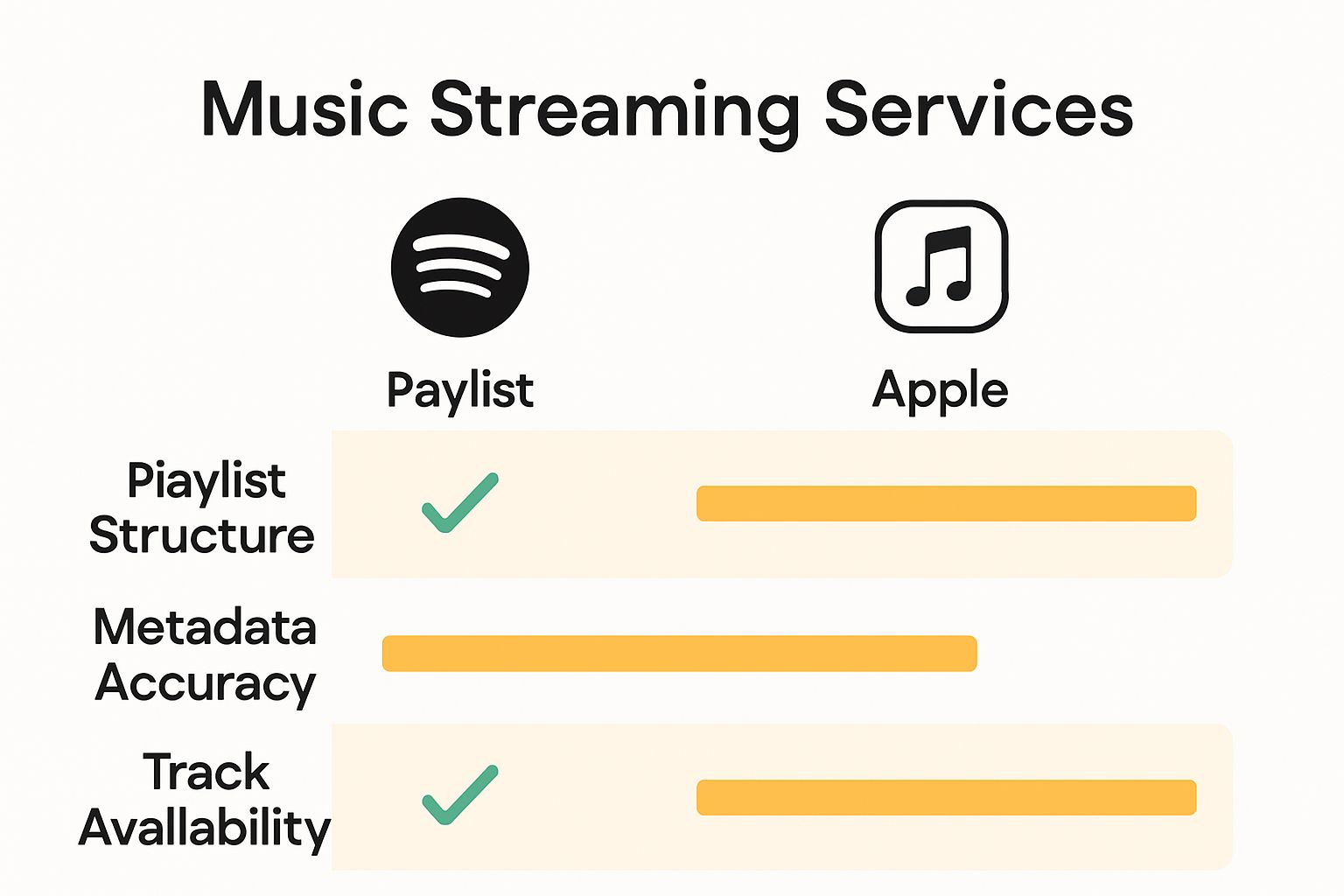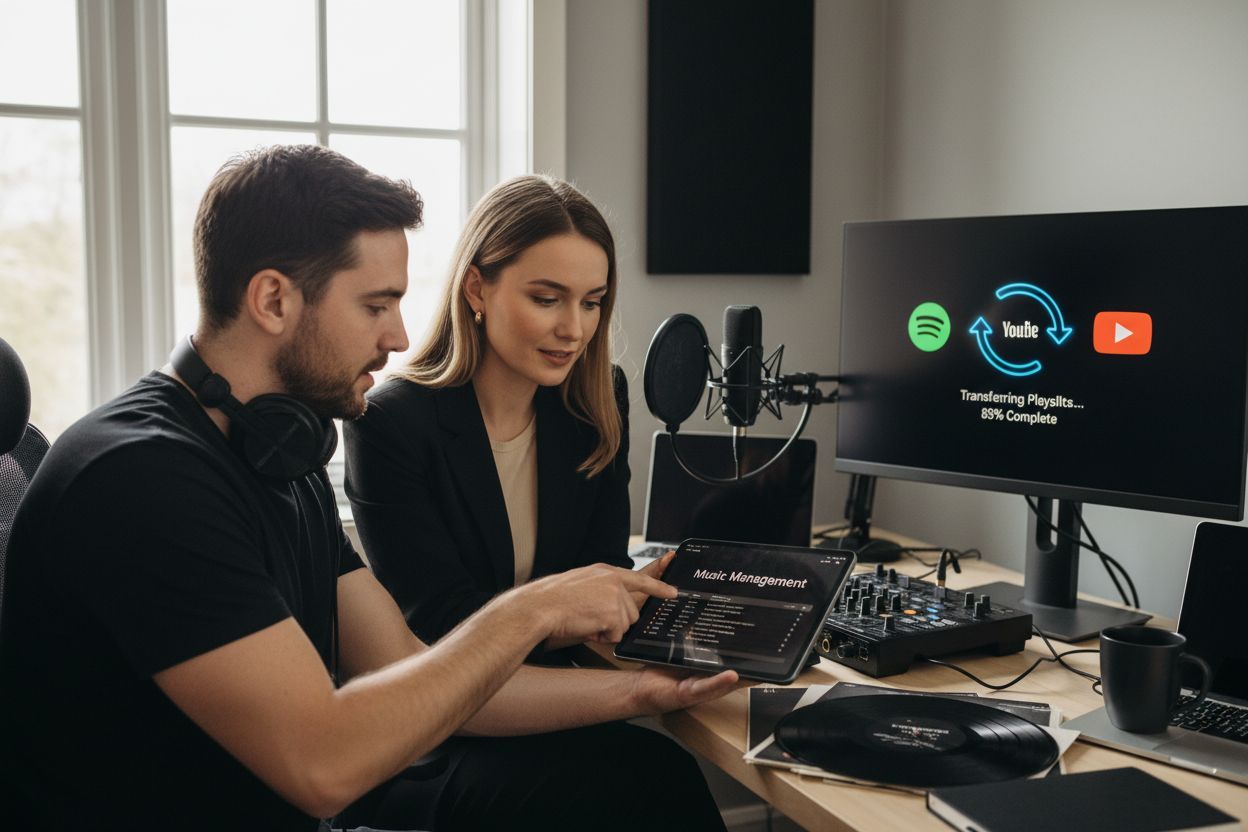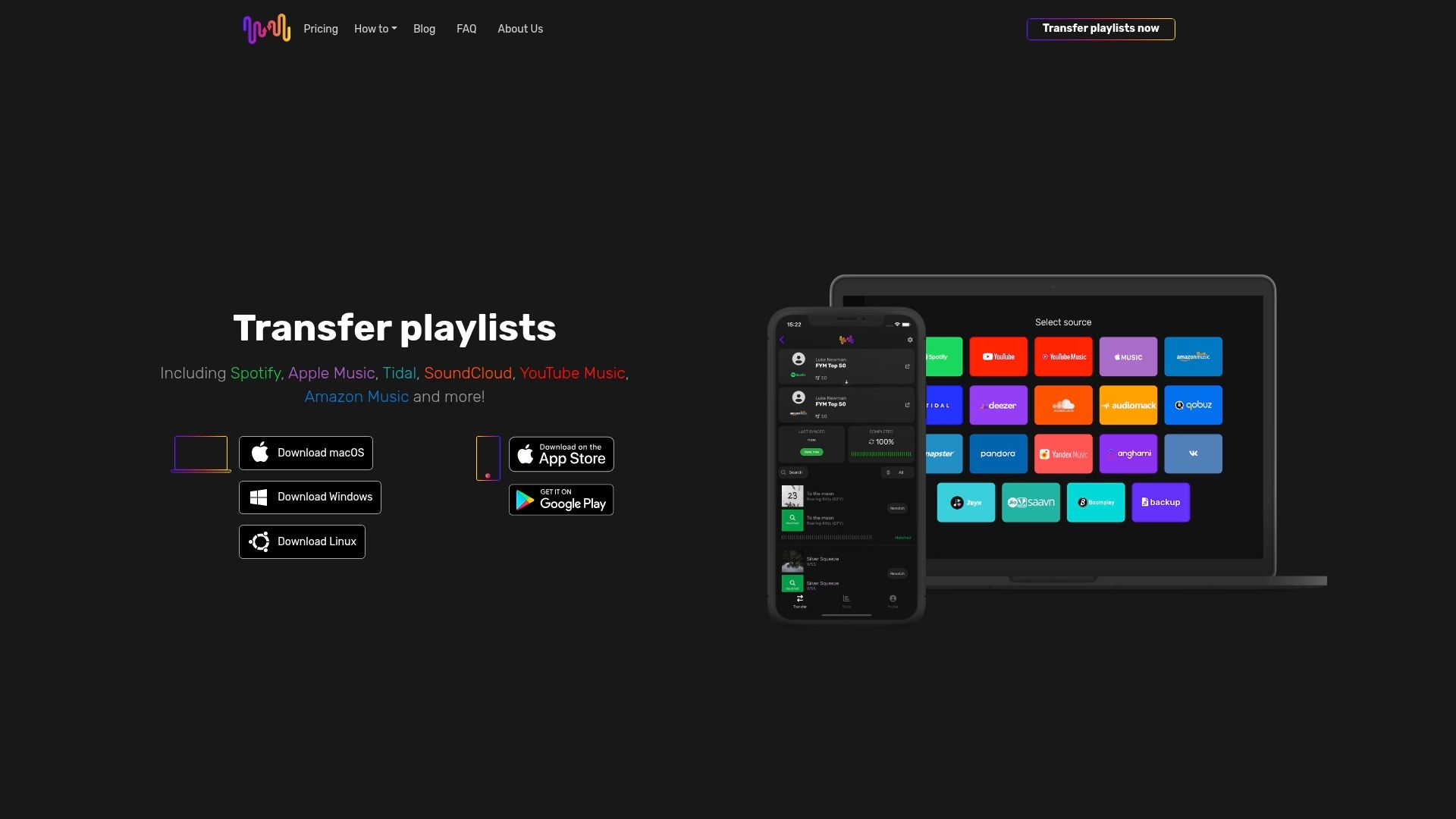Moving your entire music library from one streaming platform to another sounds like a hassle. Over 60 percent of music listeners have switched services at least once, yet most worry about losing their playlists and favorite tracks. What surprises many is that modern transfer tools now use algorithmic matching and can preserve song libraries with almost perfect accuracy, making the transition smoother than ever before.
Table of Contents
- What Is A Music Collection Transfer?
- Why Transferring Music Collections Matters
- How Music Collection Transfers Work
- Key Concepts In Music Collection Transfers
- Real-World Applications Of Music Collection Transfers
Quick Summary
| Takeaway | Explanation |
|---|---|
| Music collection transfers preserve playlists and libraries | Transfers ensure musical memories and organized libraries are maintained across different digital platforms. |
| Technology simplifies the transfer process | Advanced algorithms and tools make it easier to migrate music without losing important metadata or structure. |
| Digital preservation protects personal musical heritage | Safeguarding personal music collections helps maintain emotional connections and unique compilations that reflect individual journeys. |
| Successful transfers require understanding platform capabilities | Users must know the strengths and limitations of source and destination platforms to prevent data loss during migration. |
| Transfer systems manage complex music metadata | These systems reconcile differences in song identification and regional restrictions to ensure accurate playlist transfers. |
What is a Music Collection Transfer?
A music collection transfer represents a strategic process of moving musical libraries, playlists, and personal music archives between different digital platforms or storage systems. This comprehensive approach enables music enthusiasts to preserve their carefully curated collections while adapting to changing technology and streaming service landscapes.
The Core Concept of Music Migration
At its fundamental level, a music collection transfer involves relocating musical data from one digital environment to another without losing playlist configurations, song selections, or organizational structures. According to digital preservation research, this process is critical for maintaining the integrity and accessibility of personal music libraries across evolving digital platforms.
Music collection transfers serve multiple essential purposes:
- Preserving musical memories and curated playlists
- Adapting to new streaming service technologies
- Preventing loss of meticulously organized music libraries
- Providing flexibility in digital music consumption
Technical Foundations of Music Transfer
The technical mechanics of music collection transfers involve complex algorithmic matching systems that identify and reproduce musical selections across different streaming platforms. These sophisticated systems analyze track metadata, including song title, artist, album, and unique identifiers to ensure precise playlist reconstruction.
Users can now explore comprehensive playlist transfer solutions that simplify what was once a complicated manual process. The ability to seamlessly migrate entire music collections represents a significant advancement in digital music management, offering unprecedented convenience and continuity for music lovers worldwide.
While the process might seem straightforward, successful music collection transfers require careful preparation, understanding of source and destination platform capabilities, and utilizing specialized transfer tools designed to maintain musical library integrity.
Why Transferring Music Collections Matters
Music collection transfers have become increasingly crucial in the digital age, where streaming platforms and personal music preferences constantly evolve. These transfers are not merely technical processes but essential strategies for maintaining musical continuity and personal cultural preservation.
Preserving Personal Musical Heritage
Personal music collections represent more than just a playlist. They are auditory scrapbooks documenting individual musical journeys, emotional landscapes, and personal memories. According to the Library of Congress, digital preservation is critical for maintaining cultural and personal audio archives against the risk of permanent loss.
Music collections often encompass significant personal investments:
- Hundreds of hours curating unique playlists
- Emotional connections to specific song selections
- Rare or hard-to-find tracks
- Personalized genre and mood compilations
Technological Adaptation and Flexibility
The digital music ecosystem is dynamic, with streaming platforms emerging, changing, and sometimes disappearing. Users frequently switch between services based on features, pricing, audio quality, or content availability. Learn more about seamless playlist migration to understand how modern tools facilitate these transitions.
Key reasons for transferring music collections include:
- Avoiding manual playlist recreation
- Maintaining musical consistency across platforms
- Accessing music libraries without interruption
- Protecting personal musical investments
Successful music collection transfers represent more than technical convenience. They are about preserving personal musical narratives, ensuring uninterrupted access to cherished soundtracks, and empowering users to navigate the ever-changing digital music landscape with confidence and ease.
How Music Collection Transfers Work
Music collection transfers function through complex technological mechanisms that enable seamless migration of musical libraries across different digital platforms. These sophisticated processes involve intricate technical protocols designed to preserve the integrity and organization of personal music collections.
Metadata Matching and Track Identification
According to preservation research, the core of music collection transfers relies on advanced metadata matching algorithms. These systems analyze multiple track attributes to ensure accurate playlist reconstruction across different streaming platforms.
The metadata matching process involves several critical components:
- Analyzing song titles and artist names
- Comparing unique track identifiers
- Evaluating audio fingerprint signatures
- Checking album and release information
Technical Infrastructure of Transfer Systems
Modern music collection transfer technologies utilize robust cloud-based infrastructure that enables rapid and secure playlist migration. These systems create dynamic mapping between different streaming service databases, allowing users to explore comprehensive playlist migration solutions.
Key technical capabilities of transfer systems include:

- Real-time cross-platform song matching
- Preservation of playlist ordering and structure
- Handling regional music availability variations
- Managing metadata discrepancies between platforms
The complexity of music collection transfers extends beyond simple file copying.
Below is a table summarizing the main components and technical features that make music collection transfers possible, helping clarify how these systems work behind the scenes.
| Feature/Component | Description |
|---|---|
| Algorithmic Metadata Matching | Analyzes titles, artists, albums, and identifiers to locate song matches |
| Audio Fingerprint Analysis | Evaluates unique audio signatures for more accurate track identification |
| Cloud-Based Infrastructure | Supports rapid and secure migration between different platforms |
| Playlist Structure Preservation | Maintains playlist order and organizational hierarchy during migration |
| Handling Regional Restrictions | Manages differences in music availability based on licensing or location |
| Reconciling Metadata Discrepancies | Bridges gaps between different metadata formats on various platforms |
Key Concepts in Music Collection Transfers
Music collection transfers represent a sophisticated intersection of digital technology, metadata management, and user experience design. Understanding the foundational concepts behind these transfers helps users navigate the complex landscape of digital music preservation and migration.
Digital Preservation and Metadata Integrity
According to preservation research, digital music transfers involve critical concepts like format obsolescence, bit-level preservation, and access rights management. These fundamental principles ensure that musical collections remain accessible and intact during platform transitions.
Critical components of digital preservation include:
- Maintaining original file structure
- Preserving metadata accuracy
- Protecting against information loss
- Ensuring long-term digital accessibility
Technological Compatibility and Mapping
Successful music collection transfers depend on advanced technological mapping between different streaming platforms. These systems must navigate complex challenges such as platform-specific metadata formats, regional music licensing restrictions, and varied audio encoding standards.
Users can explore advanced playlist migration techniques that help understand the intricate processes behind seamless music library transfers. The most sophisticated transfer systems employ intelligent algorithms that can:
- Recognize track variations across platforms
- Handle multiple language and character encoding
- Manage different music library organizational structures
- Reconcile inconsistent metadata representations
Understanding these key concepts empowers users to approach music collection transfers with confidence, knowing the complex technological infrastructure working behind the scenes to preserve their musical memories and preferences.
The following table compares key concepts related to digital preservation and technological mapping that determine the success and reliability of music collection transfers.
| Concept | Explanation |
|---|---|
| Digital Preservation | Practices ensuring long-term accessibility of music files and metadata |
| Metadata Integrity | Maintaining accuracy of song data (titles, artists, albums) |
| Format Obsolescence | Addressing risks posed by outdated file or metadata formats |
| Platform Compatibility | Ability to reconcile differences between various streaming services |
| Licensing & Regional Mapping | Managing music availability based on region-specific licenses |
Real-World Applications of Music Collection Transfers
Music collection transfers extend far beyond simple technological convenience, offering practical solutions for diverse user scenarios across personal, professional, and creative domains. These transfers have become essential tools for music enthusiasts, professionals, and organizations navigating the dynamic digital music landscape.
Personal Music Management
For individual music lovers, collection transfers represent a lifeline in maintaining curated musical libraries. Users frequently switch between streaming platforms based on features, pricing, or content availability, making seamless music migration critical.
Personal music transfer scenarios include:
- Transitioning between streaming services without losing playlists
- Consolidating music libraries from multiple accounts
- Preserving rare or hard-to-find tracks
- Creating comprehensive personal music archives
Professional and Creative Applications
Professional musicians, DJs, podcasters, and music researchers leverage music collection transfers as strategic tools for content management and archival. These advanced transfer techniques enable complex musical workflows and preservation strategies.
Learn more about specialized music transfer techniques that support professional music management. Critical professional applications involve:
- Backing up performance playlists
- Managing music libraries across multiple professional accounts
- Documenting musical research collections
- Facilitating collaborative music projects
Music collection transfers have evolved from simple data migration to become sophisticated preservation and management technologies.
 They represent a critical intersection of personal passion, technological innovation, and creative expression in the modern digital music ecosystem.
They represent a critical intersection of personal passion, technological innovation, and creative expression in the modern digital music ecosystem.
Make Your Music Collection Transfer Effortless
Have you spent years curating personal playlists across different platforms, only to face the stress of moving them when your digital landscape changes? The article spotlighted the challenges of preserving playlist structures, metadata accuracy, and keeping your music memories intact during transfers. Many music lovers worry about losing hours of curation or facing tedious manual rebuilding when switching services.

Take control of your music with Free Your Music. Our specialized playlist transfer solution is designed for easy, secure migration between services like Spotify, Apple Music, Tidal, YouTube Music, and more. With automated syncing, accurate matching, and unlimited transfers, you never have to risk losing your playlists again. Start your protected transfer today at https://freeyourmusic.com and make every move for your music collection completely stress-free.
Frequently Asked Questions
What is a music collection transfer?
A music collection transfer is the process of moving musical libraries, playlists, and personal music archives between different digital platforms or storage systems while preserving the integrity and organization of the collection.
Why is transferring music collections important?
Transferring music collections helps preserve personal musical heritage, prevents loss of carefully curated playlists, and allows users to adapt to changing streaming services without losing their musical continuity.
How do music collection transfers work technically?
Music collection transfers utilize complex algorithmic matching systems that analyze track metadata to ensure accurate migration of playlists and musical selections across different streaming platforms, preserving organization and compatibility.
What are the benefits of using specialized tools for music collection transfers?
Specialized tools simplify the transfer process, allowing users to avoid manual playlist recreation, maintain musical consistency, and manage regional music availability while ensuring the integrity of their music libraries.




